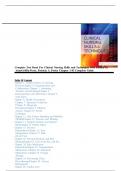Exam (elaborations)
TEST BANK FOR CLINICAL NURSING SKILLS AND TECHNIQUES 10TH EDITION BY ANNE GRIFFIN PERRY, PATRICIA A. POTTER CHAPTER 1-43 |COMPLETE STUDY GUIDE |GRADE A+.
TEST BANK FOR CLINICAL NURSING SKILLS AND TECHNIQUES 10TH EDITION BY ANNE GRIFFIN PERRY, PATRICIA A. POTTER CHAPTER 1-43 |COMPLETE STUDY GUIDE |GRADE A+.TEST BANK FOR CLINICAL NURSING SKILLS AND TECHNIQUES 10TH EDITION BY ANNE GRIFFIN PERRY, PATRICIA A. POTTER CHAPTER 1-43 |COMPLETE STUDY GUIDE |GR...
[Show more]



